Automatic derivative method for a computer programming language
a computer programming and automatic derivative technology, applied in the field of computer programming equipment for processing computer programs, can solve the problems of not being able to overload the overloaded primitives, difficult and unwieldy to implement ad in existing functional programming languages such as scheme, ml and haskell, and not being able to implement ad
- Summary
- Abstract
- Description
- Claims
- Application Information
AI Technical Summary
Problems solved by technology
Method used
Image
Examples
Embodiment Construction
[0098]We now motivate our approach with a series of examples that illustrate points 1 through 7 from section 1. These examples have obvious numerical deficiencies. They are intended only to illustrate the power of combining AD with functional programming, not as production code. More robust methods are possible but do not differ in spirit from what we show here. Nonetheless, many of these examples run in our preliminary implementation.
[0099]One can compute the derivative of a univariate function in forward mode with:
f=ΔλxCDR(fx,1)
and in reverse mode with:
f=ΔλxCDR(fx,I)1
Note that forward mode is more efficient for computing the derivative of a univariate function than reverse mode. One can then find the root of a univariate function with the Newton-Raphson method:
ROOTf,x,ε=Δletx′=Δx-xfxinifx-x′≤εthenxelseROOTf,x′,εfiend
Note that one can use either forward mode or reverse mode to compute the derivative of f in the above, as they are interchangeable. One can then implement a univariate...
PUM
 Login to View More
Login to View More Abstract
Description
Claims
Application Information
 Login to View More
Login to View More - R&D
- Intellectual Property
- Life Sciences
- Materials
- Tech Scout
- Unparalleled Data Quality
- Higher Quality Content
- 60% Fewer Hallucinations
Browse by: Latest US Patents, China's latest patents, Technical Efficacy Thesaurus, Application Domain, Technology Topic, Popular Technical Reports.
© 2025 PatSnap. All rights reserved.Legal|Privacy policy|Modern Slavery Act Transparency Statement|Sitemap|About US| Contact US: help@patsnap.com



